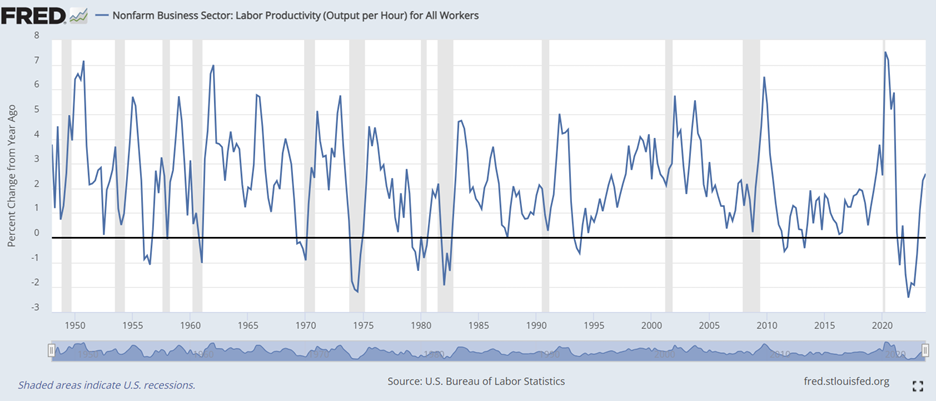Written by: Tim Pierotti
Productivity is profoundly important to our economic future. GDP is driven by two things: Workforce growth and productivity growth. Our workforce growth in the US is and will be driven entirely by immigration. Despite the justifiable concerns about illegal immigration on our southern border, immigration is one of the factors that keeps America growing and innovating far ahead of our developed world peers. However, most Americans, according to Gallup, would like to see lower levels of immigration. The benefits of immigration are nuanced at a time when nuance is giving way to populism.
For the US to achieve the kind of real (not inclusive of inflation) growth in the future that is consistent with the growth of recent decades, we will need to see strong productivity. Unfortunately, economists generally agree that we have little ability to predict future productivity. Even in hindsight, assessing the factors that drove productivity is fraught with disagreement. Productivity is volatile and hard to measure. One consistent factor is that we tend to see a rise in productivity coming out of recessions when the economy is being supported by easy monetary and fiscal policy. This makes sense given these are periods when both capacity and labor utilization should be strong, and demand is growing. Take a minute to observe the chart below where one can see a consistent history of productivity peaking post the grey bars that indicate recession.

Prior to the pandemic and importantly, prior to the emergence of AI onto the public consciousness, Fed Chair Powell and others were lamenting the fact that productivity had been rather weak from 2011 to 2018. Now, with the advent of AI, market participants are assuming that AI will change that trajectory for decades to come. But AI and technology in general are just one factor that will impact future productivity growth. We have no unique expertise on AI and we are loathe to dismiss technological innovations, but given the massive run in large cap tech, it would appear that this tailwind has been priced into markets.
There are other potential tailwinds as well such as medical and pharmaceutical innovations. It stands to reason that if GLP-1 inhibitors and similar drugs can have a meaningful impact on obesity and health, that should also benefit the ability of individuals to work and produce more.
But there are significant headwinds to consider as well. For decades, we have enjoyed the benefits of “Globalization”. Companies have had the luxury of sourcing from all over the world allowing them to grow rapidly while driving down costs. But optimal development has given way to parallel development (to borrow a phrase from Unlimited’s Bob Elliott). That subsidized parallel production growth is certainly stimulative right now, but it does suggest a future of less than robust competition and potential overcapacity. The trend of growing protectionism is clear. Sadly, the Chinese have deeply subsidized their EV auto, and energy transition industries to the point where western countries have been left with little choice but to put up tariff walls.
Another major risk to productivity is the potential for meaningfully higher energy prices. We have written extensively that the supply of oil will be restrained by underinvestment while the demand for oil is inexorably growing in emerging markets who currently consume a very small fraction of oil and oil equivalents relative to developed markets. Additionally, geopolitical tensions are rising rapidly and a new dynamic has now emerged in both the conflict in Ukraine and in the Middle East where drone technology is proving rather effective at destroying midstream (pipelines, shipping and storage) and downstream (refining capacity) production. This obviously further constrains supplies and has the promise of constraining supply secularly.
The last headwind to productivity that is worth mentioning is the trend of US workers choosing to work less in favor of a less work intensive work/life balance. Employment data has been very clear over the past year that more Americans, and notably among the most productive Americans, are choosing to work fewer hours. That suggests that our secularly tight labor market is not just being tightened by demographic realities but social realities as well.
While we have the humility to understand that we have no idea what productivity will look like over the coming years, we see the narrative around a future productivity miracle driven AI to be woefully short of a holistic view.
Related: Not So Fast, Jerome


